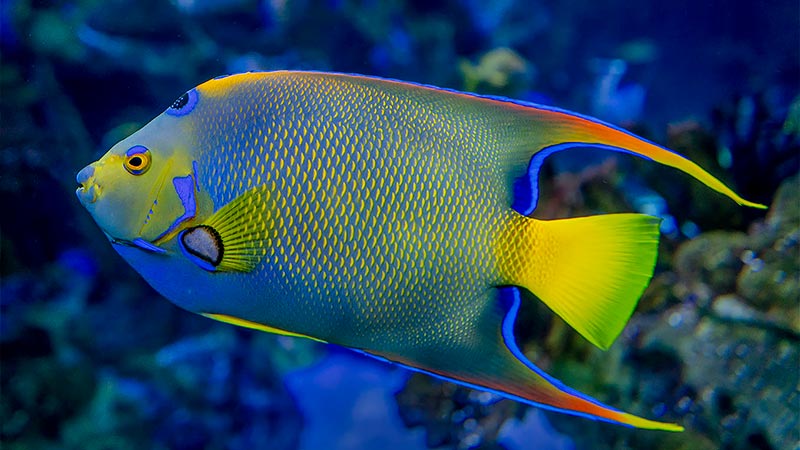Angelfish Gallery
Browse through our collection of stunning Angelfish pictures!
These beautiful swimmers glide in and out of coral reefs in the shallow parts of the ocean.
3 Fascinating Facts About Angelfish
-
Changing Colors: One of the coolest things about angelfish is how their colors change as they grow. A young angelfish’s black stripes, for example, might gradually shift to yellow as it matures. Changes in health, diet, and breeding can also affect their coloring.
-
Gender Swap: Angelfish are known as protogynous hermaphrodites, meaning that some females eventually transform into males during their lifetime.
-
Pancake Shape: Angelfish have flat, thin bodies, almost like pancakes, which help them slip through the tiny crevices of coral reefs—whether to hide from predators or nibble on algae.
Scientific Classification
The scientific name for marine angelfish is Pomacanthidae, which comes from Greek, meaning “cover thorn”—a nod to the spiny growth found on their bodies. This spine is usually located near the head or the tail.
They belong to the Pomacanthidae family and the class Actinopterygii.
Some popular species include:
-
Emperor Angelfish
-
Queen Angelfish
-
French Angelfish
-
Blue Angelfish
In total, there are around 90 known species, divided into seven different genera.
Here’s a quick list of some angelfish types:
-
Zebra Angelfish
-
Marble Angelfish
-
Black Veil Angelfish
-
Leopard Angelfish
-
Albino Angelfish
-
Blushing Angelfish
-
Koi Angelfish
-
And many more!
Evolution and Origins

The angelfish is one of the most striking freshwater fish species, famous for its unique triangular shape, vivid colors, and graceful swimming. Originating from the Amazon River basin in South America, angelfish have been known to indigenous peoples for centuries, long before European explorers first recorded them in the 19th century.
Scientifically called Pterophyllum scalare, they belong to the cichlid family, a massive group of over 2,000 freshwater fish species. Though cichlids are found worldwide, South America and Africa are their strongholds.
Angelfish evolved distinctive traits over time, such as their iconic long fins and sleek, triangular body shape, setting them apart from their cichlid relatives.
Species Spotlight

Many angelfish species thrive around coral reefs, especially in the Caribbean Sea. Here are a few you might spot:
-
Emperor Angelfish: Growing up to 15.75 inches, these vibrant blue-and-yellow fish feast on sponges and algae.
-
Queen Angelfish: Sometimes called the Blue Queen, this large fish (up to 18 inches long) also feeds mainly on sponges and the occasional jellyfish.
-
French Angelfish: Recognizable by their black bodies and yellow-ringed eyes, these angelfish stick to the eastern Caribbean’s reefs and have a similar diet focused on sponges.
Appearance

Angelfish can dazzle in shades of red, blue, green, black, yellow, or a blend of all these colors. Their bodies are thin and flat, with flowing dorsal and anal fins, delicate pectoral fins, dark eyes, and small mouths.
Every angelfish also sports a signature thorn-like spine somewhere on its body—hence their Greek name meaning “cover thorn.”
Most marine angelfish range from 8 to 12 inches long and weigh up to 2 pounds, though there’s some variation. For example, koi angelfish are petite at about 6 inches, while gray angelfish can grow to an impressive 24 inches and weigh up to 4 pounds!
Their vibrant coloring actually serves as camouflage in the bright, colorful environments of coral reefs, helping them avoid predators despite standing out to our human eyes.
Habitat and Population
You’ll find angelfish in the warm, shallow waters of the Indian, Atlantic, and western Pacific Oceans. They stick close to coral reefs and rarely dive deeper than 160 feet.
Well-known habitats include:
-
Belize Barrier Reef
-
Great Barrier Reef
-
New Caledonian Barrier Reef
While population numbers aren’t precisely known, most species are considered of Least Concern according to conservation status, indicating healthy, stable populations. However, the Bluespotted Angelfish is an exception, listed as Data Deficient due to habitat threats.
Diet and Predators
Angelfish are omnivores. Their primary diet consists of sponges, but they also munch on algae and bits of shrimp. Larger angelfish, like the Queen angelfish, even hunt jellyfish.
Predators:
Their main predators are larger fish, sharks, and barracudas—animals that share their reef habitats.
Prey:
They mainly eat sponges, but some species diversify their diet with shrimp, algae, and even jellyfish.
Reproduction and Lifespan
Angelfish spawn during the winter. Males use their pectoral fins to attract females, and they usually maintain a harem of about four females. One of the most fascinating facts: if a male leaves the group, one of the females can change into a male and take over!
After mating, females lay anywhere from 500 to an astonishing 75,000 eggs (in the case of Queen angelfish). These eggs float freely and hatch within one to three days.
Larvae are almost invisible and highly vulnerable, feeding on plankton and algae as they grow. Parents do not stick around to care for the young.
Angelfish reach sexual maturity between 6 and 12 months and can live up to 15 years.
Fishing and Consumption

While angelfish aren’t typically targeted by commercial fisheries, they are sometimes caught for the aquarium trade, adding a splash of color to tanks in homes and businesses.
They aren’t a common food source, but in some places, people do eat them. However, they may carry parasites and bacteria, so consuming them isn’t widespread.


